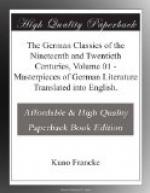Now let us consider Goethe after he had settled down in Weimar for the second time. Scientific work seems for a while to have entirely replaced poetic activity, as for a moment the scientific prose of Ranke and Helmholtz came near to being of more consequence for the German language than most of what was produced at the same time by so-called poetry. Then the Campaign in Champagne (1792), and the new employment of his time with political problems, constitutes for Goethe a temporary phase that may be compared with that recapturing of history by political-historical writers like Freytag and Treitschke, in the same way that Hermann and Dorothea (1796), in which an old historical anecdote of the time of the expulsion of the Protestants from Salzburg is transplanted to the time of the French Revolution, may be compared with the historical “Novellen” of Riehl, Scheffel, and C.F. Meyer. Goethe’s ballads (1797-1798) maintain the tradition that was to be given new life by Fontane, Strachwitz, and C.F. Meyer. Goethe’s later novels with their didactic tendencies, and the inclination to interpolate “Novellen” and diaries, lead up to Gottfried Keller, Wilhelm Raabe and again to Fontane. The table-songs and other convivial poetry of Goethe’s old age are taken up again by Scheffel; Goethe’s “Novellen” themselves were continued by all those eminent writers whom we have already named. The Divan, with its bent toward immutable relations, prepares the way for the new lyric, until finally, with the second part of Faust, mythical world-poetry and symbolism complete the circle, just as the cycle of German literature finishes with Nietzsche, Stefan George, Spitteler and Hofmannsthal. At the same time new forces are starting to form the new cycle, or, to speak like Goethe, the newest spiral: Hauptmann, Frenssen, Ricarda Huch, Enrica von Handel, to name only these. And how many others have we not previously left unnamed!




